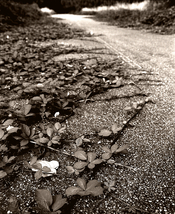Mamiya RB67 and RZ67 lenses are made in two basic configurations. The majority are standard lenses. On these, the DOF ring is simply a convenient calculator that lets you quickly determine the approximate DOF (Depth of Field). It has no effect on the image seen in the viewfinder nor on the image recorded on film.
On the “Floating System” lenses the DOF ring serves two purposes. 1. It is a DOF calculator as in the standard lenses. 2. It moves an independently moving lens group (usually a cemented doublet) that serves as a field flattener.
The problem is, at very close focusing distances, some lens designs produce a spherically curved field that doesn’t agree with the flat film plane. This is most pronounced in the corners, especially at relatively large apertures. By moving the floating group to the appropriate position forward or back inside the lens barrel, the corners of the image are refined (the curvature is “flattened”) to better agree with the film plane. This essentially sharpens the image, most noticeably in the corners, where the spherical field curvature is most pronounced. The result is a more uniformly focused image, particularly into the corners.
This isn’t evident when viewing the image in the viewfinder due to the limits of resolution of the viewing system. But it’s a definite improvement in the image recorded on film. This has the greatest benefit when photographing VERY close subjects. For subjects of average distances, say, 2 meters to infinity, you can leave the float ring at the infinity setting and your corners will be sufficiently well-resolved. It’s useful for very close subjects. Otherwise, you can leave the float ring at infinity.
Many helicoid focusing lenses, such as those found on SLR cameras, have field flatteners built in. This is most common on wide-angle and zoom lenses. These are operated by turning the focusing ring so that you automatically position the field flattener unit to the correct position without thinking about it (or even knowing about it).
Instead of using a helicoid, the RB67 and RZ67 lenses focus by moving the lens mount panel forward and back to focus like a view camera. Thus, the lenses that Mamiya determined needed field flattening, require manual actuation to position the flattening unit.
You’d get the most benefit from this near the closest limits of focus. For example. If you were shooting a small, detailed flat subject, such as a drawing, etching, copying a photo, and so forth, the corners will be best resolved by using the float ring per the instructions in post #4.










